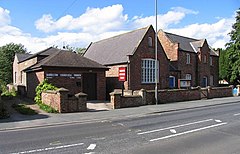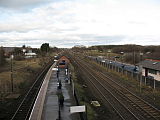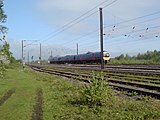Carlton Miniott
| Carlton Miniott | |
|---|---|
 Hambleton Evangelical Church and St Lawrence's Church Parish Rooms. | |
| Population | 990 |
| OS grid reference | SE393808 |
| District | |
| Shire county | |
| Region | |
| Country | England |
| Sovereign state | United Kingdom |
| Post town | THIRSK |
| Postcode district | YO7 |
| Dialling code | 01845 |
| Police | North Yorkshire |
| Fire | North Yorkshire |
| Ambulance | Yorkshire |
| UK Parliament | |
Carlton Miniott, formerly Carlton Islebeck is a village and civil parish in the Hambleton district of North Yorkshire, England, on the A61 road to the immediate west of Thirsk, 25 miles (40 km) north of York. According to the 2001 census it had a population of 926, increasing to 990 at the 2011 census.[1]
History
The village is mentioned in the Domesday Book as Carlton, as is the place-name Islebeck that has been associated with the village.[2] The land was in the possession of Orm, son of Gamal at that time and passed on to Hugh, son of Baldric. It eventually became the property of the Barons de Mowbray. In the early 14th century the lands were purchased by a John Miniott from whom the village now gets its suffix.[3] By the early 15th century the manor had passed out of the Miniott family to the Markenfield and Pigot families. Thereafter, the manor was further divided and passed through other families such as Metcalfe, Folkingham, Hussey, Lamplugh, Clough and Bell.[4]
Governance
The village lies within the Thirsk and Malton UK Parliament constituency. It is in the Thirsk electoral division of the North Yorkshire County Council and the Thirsk ward of Hambleton District Council.[5] The Parish Council has seven councillors including the Chair and meets monthly.[6] The Thirsk ward returns three councillors to the Hambleton District Council[7] and the Thirsk electoral division returns one councillor to the County Council.[8]
Geography
The village is located on the A61, Leeds to Thirsk, road. The nearest settlements are Thirsk, 2 miles (3.2 km) to the east; Sandhutton 1 mile (1.6 km) to the north-west; Skipton-on-Swale 1.6 miles (2.6 km) to the south-west and RAF Topcliffe 1.34 miles (2.16 km) to the south.[9]
Carlton Miniott is the location for Thirsk railway station, a small station served by the Sunderland to London King's Cross[10] route and the Middlesbrough to Manchester Airport lines.[11]
The village is well served by bus services to and from Thirsk.[12]
The soil in the area is a light gravel or sand laid over Keuper marl with some lower lias and alluvium also present.[4]
The 1881 UK Census recorded the population at 380. According to the 2011 UK Census, the population was 962 living in 388 dwellings, of which 763 were over sixteen years old, and of those 507 were in employment.[13]
Village amenities
There is a Post Office situated to the east of the village. There is a playing field near the turn-off for Sandhutton which is cared for and run for by a playing field committee. There are a number of Public Houses, a small holiday lodge site and a fishing lake. In between the two churches is the Parish Rooms where many events are held including the election polls.[14][15]
Education
There is a small school situated in on the west side of the village, Carlton Miniott Community Primary School.[16] The school is within the catchment area for Thirsk School & Sixth Form College.[17]
Religion
On the west side of the village there are two churches, St. Lawrence's Church and Hambleton Evangelical Church.[18][19] St Lawrence's was rebuilt in 1896 with registers dating to 1706 and is a Grade II listed building.[4][20] In 1838, a Methodist Chapel was built, but no longer functions as such.[3][4]
Notable residents
The novelist J. L. Carr was born on 20 May 1912 in one of the railway cottages at Thirsk Junction, between Carlton Miniott and Thirsk, where his father was stationmaster, and attended primary school in the village. Carr wrote:
"I scarcely can believe that from the age of five until we left Carlton Miniott when I was about eight, a better education could have been purchased. I wanted information, and it was provided. I preferred order, and there was order. I needed others to emulate, and they were there. I was learning all the time."[citation needed]
Gallery
-
Thirsk railway station
-
Carlton Miniott primary school
-
Carlton Miniott post office
-
Vale of York public house, Carlton Miniott
-
The Dog and Gun pub in Carlton Miniott
-
Thirsk Milepost at Carlton Miniott
-
East Coast Main Line, taken from the track that runs up the eastern side of the works, north of Thirsk Station.
References
- ^ "Parish population 2011". Retrieved 1 August 2015.
- ^ Carlton Miniott in the Domesday Book
- ^ a b Bulmer's Topography, History and Directory (Private and Commercial) of North Yorkshire 1890. S&N Publishing. 1890. pp. 665, 666. ISBN 1-86150-299-0.
- ^ a b c d "History". Retrieved 18 November 2012.
- ^ Ordnance Survey
- ^ "Parish Council". Retrieved 18 November 2012.
- ^ "District Councillors". Retrieved 18 November 2012.
- ^ "County Councillor". Retrieved 18 November 2012.
- ^ Google Maps
- ^ "London Rail route". Retrieved 18 November 2012.
- ^ "Trans Pennine Rail route" (PDF). Retrieved 18 November 2012.
- ^ "Bus services". Retrieved 18 November 2012.
- ^ "2001 Census stats". Retrieved 18 November 2012.
- ^ "Amenities". Retrieved 18 November 2012.
- ^ "Public Houses". Retrieved 18 November 2012.
- ^ Primary School
- ^ "Secondary Education". Retrieved 18 November 2012.
- ^ Evangelical Church
- ^ "Churches". Retrieved 18 November 2012.
- ^ "Listed building". Retrieved 18 November 2012.
External links
![]() Media related to Carlton Miniott at Wikimedia Commons
Media related to Carlton Miniott at Wikimedia Commons







